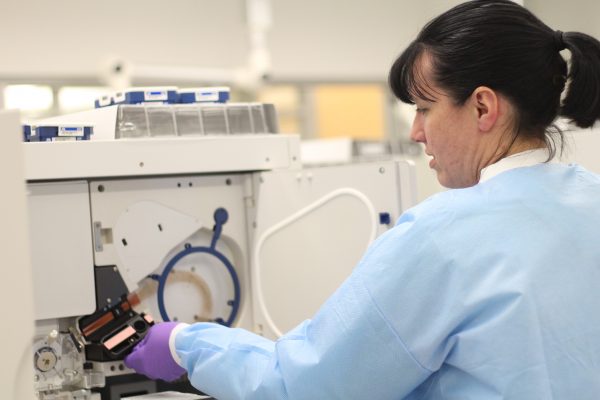
An investigation by the Anchorage Daily News and ProPublica found law enforcement agencies in Alaska have routinely failed to comply with a state law requiring the collection of DNA from some criminal offenders.
The DNA is supposed to go into a database that can help police connect offenders to unsolved crimes, including rape and murder. But according to the ADN’s reporting, that’s not what’s happening.
Anchorage Daily News reporter Kyle Hopkins spoke with Alaska Public Media’s Casey Grove about the story.
LISTEN HERE:
Read a full transcript of the conversation below, with minor edits for clarity:
Casey Grove: An investigation by the Anchorage Daily News and ProPublica found that law enforcement agencies in Alaska have routinely failed to comply with a state law requiring the collection of DNA from some criminal offenders. But according to the ADN’s reporting, that’s not what’s happening. Anchorage Daily News reporter Kyle Hopkins is here to talk about it. And a quick warning to listeners the details of this might be disturbing.
Kyle, first of all, what is this: who’s supposed to get their DNA collected and why?
Kyle Hopkins: Well, the law is really broad in Alaska. And by that, I mean, it’s intended for law enforcement and jailers to collect DNA from anyone arrested for a crime against a person, which is of course, sexual assault and murder — but it’s also robbery, simple assault, things like domestic violence, even misdemeanors, which is a really common charge. And back in 2007, the legislature added some language to the law. It already said that if you were convicted of certain crimes, you’d have your DNA collected. But our law says that when you’re arrested for those crimes, you’re also supposed to have a swab of DNA taken, just that Q-tip in the mouth type of swab. And so it really should be applying to lots of arrests.
CG: There’s this really unsettling example of what happens, at least in this one case, when DNA collection doesn’t occur. Tell me about Alfonzo Mosley.
KH: In 2009, there was a sexual assault where, you know, a rape kit was taken, evidence was collected, and it had DNA that at the time was unknown. That’s the thing about the rape kits — they have DNA evidence of a suspect. But you also have to be able to figure out who that suspect is. You can test all the kits, but if you don’t have a database full of the identities of offenders, then what are you going to match it against?
What happened was, in 2009, and then again in 2012, DNA had been collected from sexual assault victims. It ended up matching Mosley, but nobody knew it at the time, even though Mosley had been out of jail. And he was being arrested on things like domestic violence where his DNA should have been collected.
You have someone who could have been flagged or determined as the suspect years earlier if everyone had followed the law which is already on the books. And instead, he remained free for another eight years. And according to the charges, committed multiple additional sexual assaults in Anchorage.
CG: How has the DNA collection gone since this law was passed?
KH: Well, we don’t know how many samples have been missed — some other states do that. The most surprising thing to me about reporting the story is that it’s not an Alaska problem: It’s really a national problem.
I think everyone has gotten used to hearing about untested rape kits and backlogs of rape kits. And I think what you’re going to see in the next year or two is a lot more stories about the other side of the coin, which is well, what about all the uncollected DNA from offenders?
Tennessee, for example, they’ve estimated 76,000 missing samples. Washington state has estimated they’ve missed tens of thousands of samples. It’s not a stretch to think there’s probably thousands of missed samples in Alaska, although we don’t know, and the state says they’re going to try and quantify that.
But, I asked every police department I could, ‘Hey, do you collect DNA upon arrest?’ And someone said, ‘No, we don’t. That’s not our job.’ Contrary to state law, they just said it wasn’t their job.
In one case, I literally had to send the law to somebody to say, ‘No, look, it’s right here. You know, that’s a law on the books. You’re supposed to do that.’ They said, ‘Well, nah, that seems like that’s the Department of Public Safety is supposed to do that.’
There are some police departments that do it, and recognize it’s part of their responsibilities, but they’ve only done it for a few years. And I think that might be because about three years ago, the Department of Law sent out a pretty alarming email to every police department saying, ‘Hey, we’re missing people. People are slipping through the cracks when they’re booked into jail upon arrest. Can you help us collect this DNA?’ And that was late 2017. So, it’s really been something the state has known about for some time.
CG: Why did this happen? Is it a lack of funding? Is it lack of guidance from the state? What do you think happened here?
KH: Well, I think you probably have an unfunded mandate, in that the legislature writes what sounds like a good idea to them. What was said at the at the committee hearings at the time was was like, ‘We already collect their fingerprints, we take a mug shot, why wouldn’t we just do the swab?’ It costs like $3, put it in a bag, you know, send it to the crime lab, and then put that person in the database.
And where it falls apart is the bureaucracy of how that actually works, right? Because the law says the Department of Public Safety shall ensure this happens. So, already you have police departments who can say, well, that’s not really our problem. And then the Department of Corrections, when they’re booking someone at the Anchorage Jail, do they have a way of knowing DNA needs to be sampled and then a way of writing it down?
One thing that struck me was — I was looking at the paperwork for Mosley. And you see the form where, you know, he’s booked into jail, there’s like a little checkbox or something for his fingerprints. They took his fingerprints, but there’s no box for the DNA. Right? So when you pass a law like that, you have to create a process by which to make sure it’s enforced. And it seems like that didn’t really happen.
Casey Grove is host of Alaska News Nightly, a general assignment reporter and an editor at Alaska Public Media. Reach him at cgrove@alaskapublic.org. Read more about Casey here.





